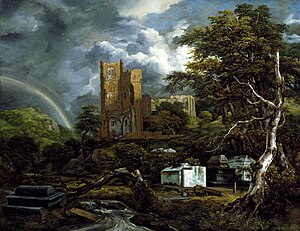User:Johannes der Taucher/sandbox/RuisdaelJoodsekerkhof2023
The Jewish Cemetery is an oil-on-canvas painting by the Dutch landscape painter Jacob van Ruisdael, now at the Detroit Institute of Arts.[1] The
| The Jewish Cemetery | |
|---|---|
| Dutch: Joodse kerkhof or Joodse begraafplaats | |
 | |
| Artist | Jacob van Ruisdael |
| Year | 1654 or 1655 |
| Medium | Oil on canvas |
| Dimensions | 142.2 cm × 189.2 cm (56.0 in × 74.5 in) |
| Location | Detroit Institute of Arts, Detroit, MI 48202 |
| Accession | 26.3 |
Jewish Cemetery may function as an allegory for hope and death,[2] while also interpreting the landscape of Beth Haim, a cemetery on Amsterdam's outskirts at Ouderkerk aan de Amstel. Beth Haim was a prominent resting place for members of Amsterdam's large Jewish Portuguese community in the 17th century.[3] The tomb monuments commemorate the leaders of the newly arrived Portuguese-Jewish community.[1] The central elements of the painting differ from what one would see in Ouderkerk, as Ruisdael made adjustments to achieve the painting's compositional and allegorical intent.[2] This picture's dimensions are twice that of typical landscape Dutch paintings from the mid-17th century.[3] After being cataloged in England in 1835, the work disappeared from public display for many years,[4] before emerging at various art auctions in London and Berlin.[2][5] The Detroit Institute of Arts acquired the painting in 1926 from Julius H. Haass, given in memory of his brother.[6]
- Jacob van Ruisdael painted two versions of The Jewish Cemetery in 1653 and 1655 in what would have been the artist's mid-twenties, according to Erich Simon.[1]
- Strike "While growing up in Haarlem, his father, Isaak van Ruisdael, and uncle Salomon van Ruisdael taught him painting" because not relevant.
- reword depicting / allegory
- while also . . . depicting
- fix up note 4, including H. = Helen
- avoid language like "on the radar"
- article at note 4 does not explain sentence
- note one lose caps, single inverted comma
- diction on artist's age
Subject and symbols edit
In his painting, Jacob van Ruisdael presents the cemetery as a landscape variant of a vanitas painting. Vanitas paintings tend to be still-life or genre scenes, with skulls, books, flowers, and candles are common subjects in this theme. Similarly, Ruisdael used a scene of deserted tombs, ravaged churches, stormy clouds, dead trees, changing skies, and flowing water to symbolize death and the transience of all earthly things.
The building foundations in the picture appear overrun by leafy foliage arising from decaying wood in the foreground. Other symbols of death prevail: as the brook rushes over large stones under the broken arch, suggesting life's fast-flowing passage. Beams of light, however, break through billowing rain or storm clouds in the upper sphere. The upright but broken column, presented as a half-cylinder, further signifies a the end of life. In addition to serving as a memento mori, a reminder of death's inevitability, the painting also contains themes of hope and renewal. Water constantly flows, changes, and regenerates in the stream, symbolizing life while the decaying tree bending over it represents death's inevitable arrival. The rainbow may be regarded as a symbol of hope and divine promise. At the top of the picture, the curve in the rainbow arc, is like a bridge to the heavens. It has also been theorized to symbolize the renewal of life, connecting the work to a theological message, as rabbis have said that the resurrection of the dead would be the first sign that the moshiach (the anointed one from the House of David) is coming. This message would be clear to Portuguese Sephardi, who would wait for this event within Beth Chaim. It is possible that this added meaning would have been at the direction of a patron, though it is unknown who, if anyone, commissioned the painting. ZELL DISBUTES Nature revitalizes and replenishes neglected areas as they become submerged in encroaching woodland over time. CITE FOR EACH LINE or REWRITE with QUOTATIONS
Add map: Gem-Ouderkerk-2014Q1.jpg or better Ouderkerk 1867.png from 1867
Add to infobox: accession number 26.3 + Dutch name joodse kerkhof of De Joodse begraafplaats
Add categories (replace) Cemeteries in art, Jewish cemeteries in the Netherlands, Dutch Golden Age paintings
Exhibitions edit
- Rings: Five Passions in World Art, High Museum of Art, Atlanta, Georgia, July 4, 1996–September 29, 1996.
- The Glory of the Golden Age, Rijksmuseum, Amsterdam, The Netherlands, April 15, 2000–September 17, 2000.
- Rembrandt and the Golden Age: Highlights from the Detroit Institute of Arts, Detroit Institute of Arts, Detroit, Michigan and the Frist Center for Visual Arts, Nashville, Tennessee, February 1, 2013–May 19, 2013.
Note revised citations from lead paragraph:
- ^ a b c Scheyer, Ernst (1977). "The Iconography of Jacob van Ruisdael's 'Cemetery'". Bulletin of the Detroit Institute of Arts. 55 (3): 133–146. ISSN 0011-9636.
- ^ a b c Nadler, Steven (2003). Rembrandt's Jews. University of Chicago Press. ISBN 978-0-226-56737-2.
- ^ a b Kutasz Christensen, Theresa A. (January 11, 2021). "Jacob van Ruisdael, The Jewish Cemetery". Smarthistory. Retrieved 19 April 2023.
- ^ Rosenau, Helen (1958). "The Dates of Jacob van Ruisdael's "Jewish Cemeteries"". Oud Holland. 73 (1): 241–242. ISSN 0030-672X – via Brill.
- ^ Rosenberg, Jacob (February 1926). "'The Jewish Cemetery' by Jacob van Ruisdael". Art in America and Elsewhere, An Illustrated Bi-Monthly Magazine. 14 (2): 37–44.
- ^ Valentiner, William Reinhold (February 1926). "The Cemetery by Jacob van Ruysdael" (PDF). Bulletin of the Detroit Institute of Arts. 7 (5): 55 – via DALNET.